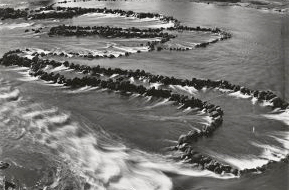A traditional Aboriginal woven eel trap made by Yvonne Koolmatrie in 1991. Traps such as these were used in conjunction with complex stone arrangements. Reproduced courtesy of Yvonne Koolmatrie. ANMM Collection 00015871.
Stephen Gapps, An Australian Stonehenge?, ANMM Blog, 11 January 2017

Traditional owners will find out next month if their push for a 6,000-year-old network of eel traps in south-west Victoria is to be supported for inclusion on the UNESCO World Heritage List. The eel-farms were built by the Gunditjmara people in south west Victoria to manage eels in Lake Condah and nearby Darlot Creek. They are among the earliest surviving examples of aquaculture in the world.
The eel farms cover more than 75 square kilometres and include artificial channels and ponds for separating eels, as well as smoking trees for preserving the eels for export to other parts of Australia. Just to be clear, this industry and the complex of stone arrangements including houses began around 6,000 years ago – before Stonehenge and the Pyramids.
Known as Budj Bim, the site received national heritage listing in 2004 and has been put forward for inclusion in the Australian government’s nomination to the UNESCO World Heritage Council by the Victorian government, at the instigation of the Gunditjmara people.
The Budj Bim landscape was the area where Robbery Under Arms author Rolf Boldrewood described the Eumeralla Wars. From the late 1830s as squatters rushed to take the fine grazing lands in southwest Victoria that Major Thomas Mitchell had written glowlingly about after his 1836 journey through the area, the Gunditjmara people fought against the squatters for their lands.
Rolf Boldrewood – himself a squatter in the area in the 1840s (his real name was Thomas Alexander Browne) recalled the warfare conducted amongst the rocky and intricate landscape of the Budj Bim – a landscape that was important during guerrilla warfare conducted for over twenty years. After a bitter and bloody struggle including several massacres of Aboriginal people according to Boldrewoode-Browne, some remaining Aboriginal people were relocated to reserves. But many refused to move from their traditional lands.
In 1868 the Victorian government established a mission for the people who had survived the settlers onslaught at Lake Condah, close to some of the eel traps and within sight of Budj Bim. The mission station was officially closed in 1919 and the mission church destroyed by the 1950s. The Gunditjmara continued to live in the area and protect their heritage. According to elder Ken Saunders the Gunditjmara people had continued to trap eels as well.
The mission lands were returned to the Gunditjmara in 1987. They were awarded native title over the area in 2007 and proceeded to restore the lake that non-Indigenous farmers had drained in the late 19th century. The eel traps began to fill again.
The traps are a series of canals and graded ponds, running for some 35km around the lake. Gunditjmara people manipulated water levels to encourage eels to swim into holding ponds and placed funnel-shaped baskets at the spillway between ponds to ensure that smaller eels could slip through and larger eels be harvested.
Eels were transferred from one pond to another, just like a fish hatchery today, and they would be grown until of an edible size. They may also have been stocked from outside the area as well. When the eels were harvested they could be eaten there and then, or smoked in hollows of the Manna Gum for later preservation and trade with other communities.
The traps and other abundant wildlife provided by the lake allowed the Gunditjmara people to remain in one central place, rather than following the food resources over the seasons. Accordingly, they built stone houses around the lake. Archaeologists have suggested there were even villages of stone buildings among the potentially hundreds of stone structures in the area. These are also included in the world heritage status application.

